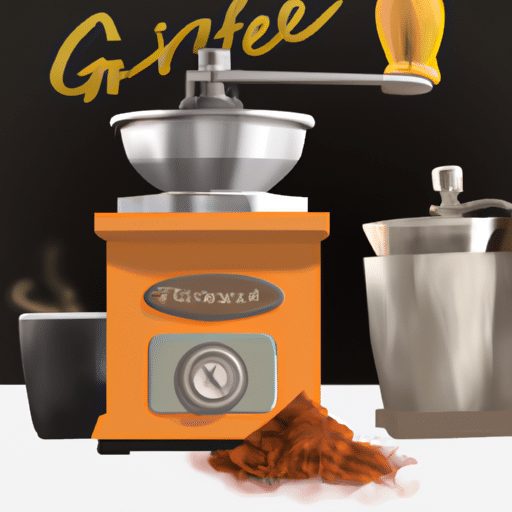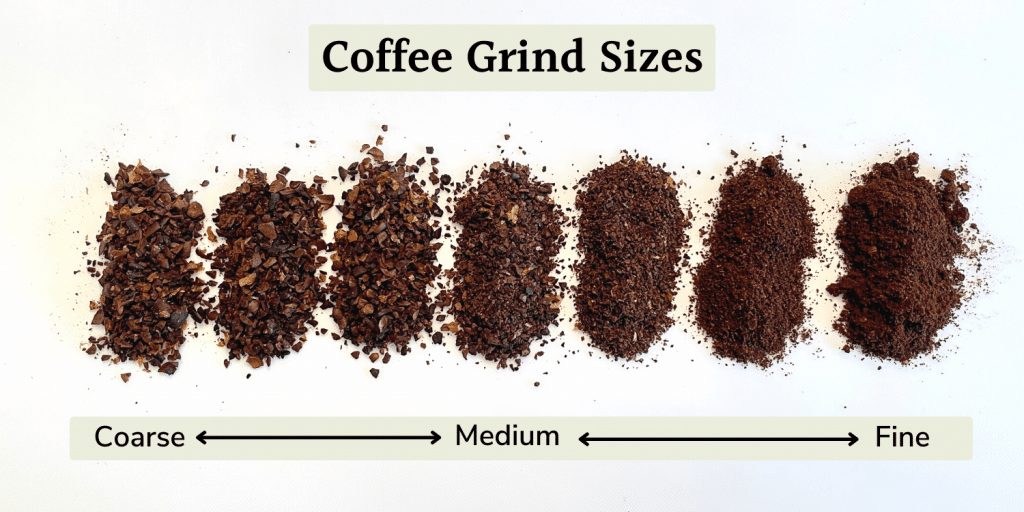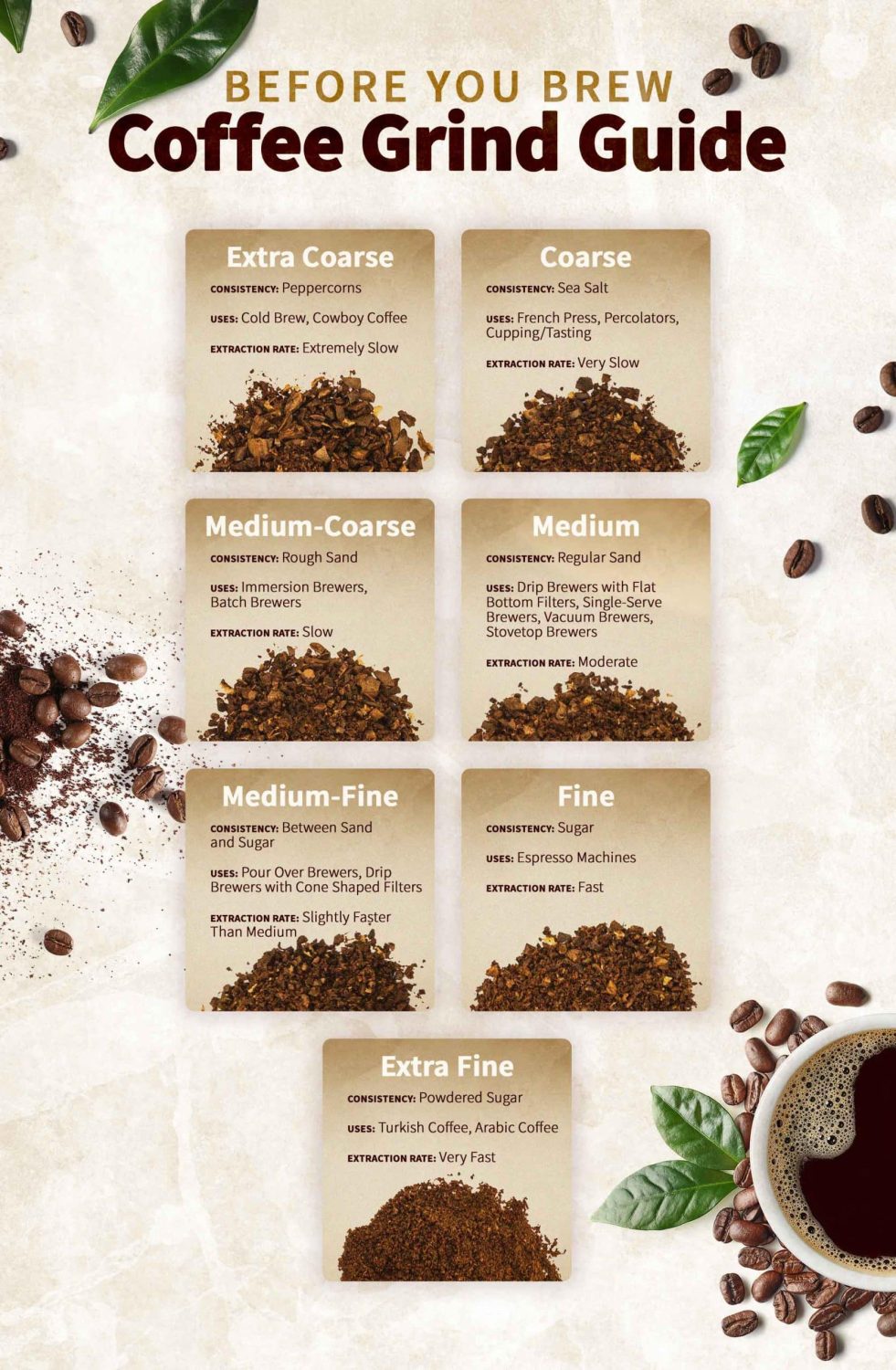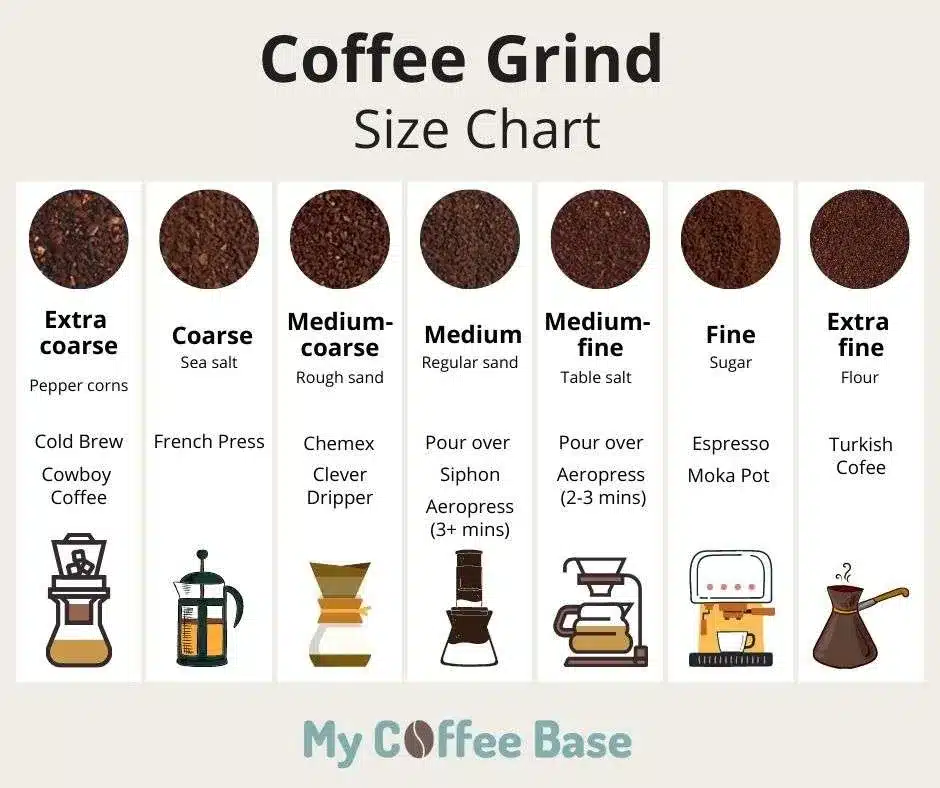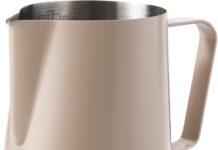Are you a coffee lover like us? Making the perfect cup of coffee is an art, and one of the key factors in achieving that perfection is grinding the beans to the ideal size. But with so many brew methods out there, it can be overwhelming to know exactly how fine or coarse you should grind your coffee beans for each one. In this article, we are going to break it down for you, providing a clear and simple guide to help you navigate the world of coffee grinding and make the most delicious cup of your favorite brew. So, grab your coffee mug and let’s embark on this flavorful journey together!
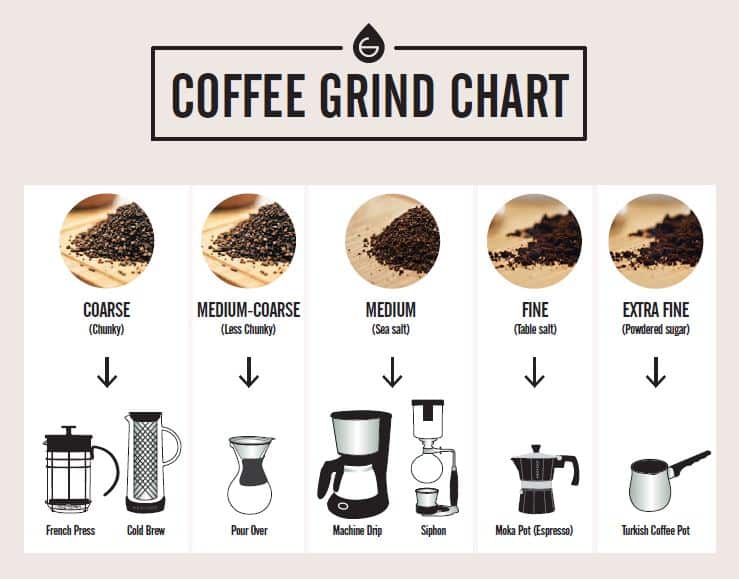
Espresso
Overview
Espresso, often referred to as the “purest” form of coffee, is a concentrated and full-flavored beverage that is the foundation of many other popular coffee drinks. It is made by forcing hot water through finely ground coffee beans under high pressure. The result is a rich, velvety, and intense shot of coffee that is enjoyed by many coffee enthusiasts worldwide.
Grind Size
When it comes to espresso, the grind size is crucial. It needs to be very fine, almost resembling powdered sugar. This fine grind allows for maximum extraction of flavors and oils from the coffee beans, resulting in the intense flavor and aroma that espresso is known for. If the grind is too coarse, the water will pass through too quickly, resulting in a weak and under-extracted shot of espresso.
Extraction Time
The extraction time for espresso is relatively short, usually between 20 to 30 seconds. This limited contact time between the water and the coffee grounds ensures that the shot is not over-extracted, which could lead to a bitter taste. The goal is to extract just the right balance of acidity, sweetness, and bitterness from the beans to achieve a well-rounded flavor profile. Baristas are often trained to closely monitor the extraction time to consistently produce high-quality espresso shots.
Pour Over
Overview
Pour over coffee is known for its simplicity and bright, clean flavors. It is made by pouring hot water over a bed of coffee grounds, allowing the water to slowly seep through and extract the flavors. This method offers control over the brewing process, allowing us to fully appreciate the nuances and delicate notes of different coffee beans.
Grind Size
When brewing pour over coffee, a medium-fine grind is typically recommended. This grind size allows for a balanced extraction, with enough surface area for the water to extract flavors but not too fine that it clogs the filter. The aim is to extract the coffee’s bright acidity and delicate flavors without any unwanted bitterness.
Brew Time
The brew time for pour over coffee can vary depending on the desired strength and flavor profile. On average, it ranges between three to four minutes. During this time, we slowly pour hot water over the grounds in a circular motion, allowing the water to fully saturate the coffee and extract the flavors. The slow and controlled pour ensures an even extraction and allows us to fine-tune the strength of the brew.
Pouring Technique
The pouring technique plays a crucial role in pour over coffee. It’s important to pour the hot water evenly and gently over the grounds, avoiding any concentrated pours in one spot. This ensures that all the coffee grounds are evenly steeped and extraction is even. By mastering the pouring technique, we can achieve a perfectly balanced and flavorful cup of pour over coffee.
French Press
Overview
The French press, also known as a press pot or plunger pot, is a classic brewing method loved for its full-bodied and rich coffee. It involves steeping coarsely ground coffee in hot water and then using a plunger to separate the grounds from the brewed coffee. This method allows for a longer steeping time, resulting in a robust and full-bodied flavor profile.
Grind Size
For French press coffee, a coarse grind is recommended. The coarser grind allows for a slower extraction process. It also helps to prevent the small coffee particles from passing through the metal mesh filter, which would result in a gritty and muddy cup of coffee.
Brew Time
One of the key advantages of using a French press is the longer brew time. The coffee and water are steeped together for about four to five minutes. This extended steeping time allows for a full extraction of flavors, resulting in a stronger and more robust cup of coffee.
Pressing Technique
When the brew time is complete, it’s time to press down the plunger slowly and evenly. This separates the coffee grounds from the brewed coffee, ensuring a clean and sediment-free cup. It’s important to apply gentle pressure and avoid rushing the process to prevent any unwanted bitterness from over-extraction.
Aeropress
Overview
The Aeropress is a versatile and portable brewing method that is loved for its ease of use and ability to produce a wide range of coffee flavors. It is a device that combines immersion and pressure to extract the flavors of the coffee. The result is a smooth and clean cup of coffee that can be enjoyed in various ways.
Grind Size
When using the Aeropress, a medium-fine to medium grind size is recommended. This allows for a balanced extraction of flavors without being too fine that it clogs the filter or too coarse that it under-extracts the coffee. Experimenting with different grind sizes can help us find the perfect balance for our preferred flavor profile.
Brew Time
The brew time for Aeropress can range between one to two minutes. The coffee grounds are steeped in hot water for a short period, saturating the water with the coffee’s flavors. The shorter brew time compared to other methods ensures a more efficient extraction, resulting in a clean and vibrant cup of coffee.
Inverted Method
One popular brewing technique with the Aeropress is the inverted method. It involves flipping the Aeropress upside down and placing the plunger on the brewing chamber. This creates a seal and allows for a longer steeping time without any liquid dripping through. Once the desired brew time is complete, the plunger is gently pressed down, forcing the brewed coffee through the filter and into the cup.
Siphon
Overview
The siphon, or vacuum coffee maker, is a visually impressive brewing method that combines immersion and vapor pressure to brew coffee. It creates a unique and flavorful cup of coffee that often highlights delicate and subtle notes.
Grind Size
For siphon brewing, a medium-coarse grind size is recommended. This helps to prevent the coffee from over-extracting during the immersion phase and allows the vapor pressure to push the brewed coffee back into the lower chamber.
Brew Time
The brew time for siphon coffee is relatively short, lasting anywhere between one and three minutes. The water in the lower chamber is heated, creating vapor pressure that forces it into the upper chamber where the coffee grounds are steeping. After the desired brew time, the heat source is removed, and the brewed coffee filters back into the lower chamber as the vapor condenses.
Vacuum Pressure
The siphon brewing method relies on the vacuum pressure created during the brewing process. This pressure helps to extract flavors from the coffee grounds and contributes to the unique and nuanced taste of siphon-brewed coffee. The use of heat and vapor pressure in this brewing method offers a captivating visual experience while producing a superb cup of coffee.
Cold Brew
Overview
Cold brew coffee has gained popularity for its smooth, low-acidity, and refreshing taste. It is made by steeping coffee grounds in cold or room temperature water for an extended period, resulting in a concentrated coffee extract that can be diluted with water or milk.
Grind Size
When making cold brew, a coarse grind size is recommended. The larger particles prevent the coffee from becoming over-extracted during the extended steeping process. A coarse grind also helps to reduce the amount of sediment that can make its way into the final cup.
Steeping Time
Cold brew requires a longer steeping time compared to other brewing methods. It typically ranges between 12 to 24 hours, depending on personal preference and desired strength. During this time, the coffee grounds slowly release their flavors into the water, resulting in a smooth and less acidic brew.
Filtering
After the steeping time is complete, the coffee needs to be filtered to separate the grounds from the cold brew concentrate. This can be done using various methods such as using a fine-mesh sieve, a cheesecloth, or a paper filter. The filtered cold brew is then ready to be enjoyed, either diluted with water or served over ice.
Moka Pot
Overview
The Moka pot, also known as a stovetop espresso maker, produces a strong and concentrated coffee reminiscent of espresso. It uses steam pressure to extract flavors from the coffee grounds, resulting in a rich and flavorful cup.
Grind Size
For the Moka pot, a medium-fine grind is recommended. This allows for an optimal extraction of flavors and oils from the coffee grounds. A finer grind size can lead to over-extraction and a bitter taste, while a coarser grind may result in under-extraction and a weak brew.
Brew Time
Brewing coffee with a Moka pot is relatively quick compared to other methods. The brewing process typically takes around five minutes from start to finish. The water in the bottom chamber heats up, creating steam pressure, which forces the water through the coffee grounds and up into the top chamber, ready to be poured.
Heat Source
The Moka pot is designed to be used on a stovetop, using a direct heat source such as a gas or electric burner. It’s important to carefully monitor the heat during the brewing process to prevent overheating or burning the coffee. The gentle heat and steam pressure combine to produce a concentrated and robust cup of coffee.
Turkish Coffee
Overview
Turkish coffee is a traditional brewing method that dates back centuries. It is known for its rich and intense flavor, as well as the unique preparation process involving finely ground coffee brewed in a cezve or ibrik.
Grind Size
For Turkish coffee, an extremely fine grind size is necessary to achieve the desired texture and flavor. The coffee should be ground to a powder-like consistency, even finer than that used for espresso. This allows the coffee to dissolve fully in the water during brewing, creating a thick and velvety beverage.
Brew Time
Brewing Turkish coffee is a delicate and precise process that requires attention to detail. The coffee and water are combined in the cezve or ibrik, and slowly heated over a low flame. The brew time is relatively short, typically lasting between two to three minutes, as the goal is to bring the coffee to a gentle simmer without allowing it to boil.
Serving Method
When serving Turkish coffee, it is customary to pour it into small demitasse cups, often accompanied by a glass of water. The coffee is traditionally consumed slowly, allowing the sediment to settle at the bottom of the cup. The serving method and the unique brewing process contribute to the ritualistic and enjoyable experience of Turkish coffee.
Chemex
Overview
The Chemex is a beloved brewing method that delivers a clean and flavorful cup of coffee. It is known for its elegant glass carafe and thick paper filters, which help to produce a bright and sediment-free coffee.
Grind Size
When brewing with a Chemex, a medium-coarse to medium grind size is recommended. This allows for a balanced extraction, avoiding both over-extraction and under-extraction. The thick paper filters used in a Chemex require a slightly coarser grind to prevent clogging and ensure a clean cup of coffee.
Brew Time
The brew time for Chemex coffee typically ranges between four to six minutes. The coffee grounds are saturated with hot water, releasing their flavors and oils into the carafe. The slow pouring technique used in a Chemex allows for precise control over the extraction process and ensures a well-balanced cup.
Filter Thickness
A distinguishing feature of the Chemex brewing method is its thick paper filters. These filters effectively remove any undesirable sediment and oils, resulting in a cleaner and lighter-bodied coffee. The filter thickness contributes to the clarity and bright flavors that Chemex coffee is known for. It’s important to note that using the correct filter thickness is essential to achieving the desired results.
Single Serve Pod Machines
Overview
Single serve pod machines, such as Keurig or Nespresso, have become increasingly popular due to their convenience and ease of use. These machines use pre-packaged coffee pods or capsules, eliminating the need for measuring coffee grounds or dealing with any mess.
Grind Size
When using single serve pod machines, the grind size is predetermined by the manufacturer and cannot be adjusted by the user. The coffee grounds inside the pods are finely ground to ensure optimal extraction and avoid any clogging of the machine. These machines are designed to work specifically with the pre-packaged pods, which contain the correct grind size for a consistent cup of coffee.
Brew Time
Single serve pod machines are designed to brew coffee quickly, usually within a minute or two. The brewing process starts with water being heated to the ideal temperature, then passing through the pod to extract the flavors. The efficiency and speed of these machines make them a popular choice for those who value convenience and a fast cup of coffee.
Compatibility
One aspect to consider when using single serve pod machines is the availability and compatibility of coffee pods or capsules. Different machine brands work with their own specific pods, and the compatibility with third-party or generic pods may vary. It’s essential to check the compatibility of the machine and choose the pods that are designed to work best with it.


